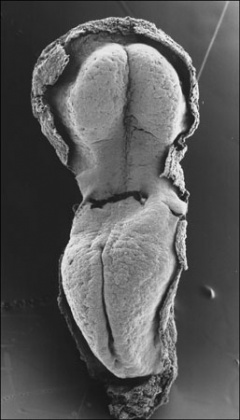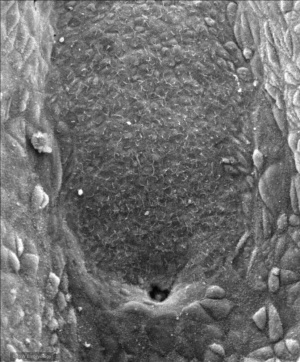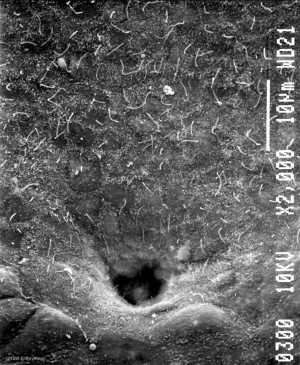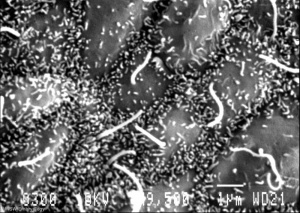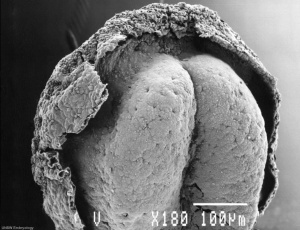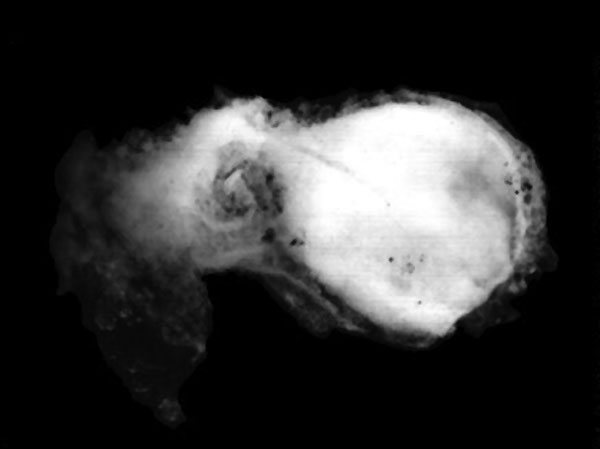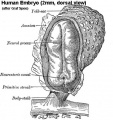Carnegie stage 8
| Embryology - 27 Apr 2024 |
|---|
| Google Translate - select your language from the list shown below (this will open a new external page) |
|
العربية | català | 中文 | 中國傳統的 | français | Deutsche | עִברִית | हिंदी | bahasa Indonesia | italiano | 日本語 | 한국어 | မြန်မာ | Pilipino | Polskie | português | ਪੰਜਾਬੀ ਦੇ | Română | русский | Español | Swahili | Svensk | ไทย | Türkçe | اردو | ייִדיש | Tiếng Việt These external translations are automated and may not be accurate. (More? About Translations) |
Introduction
|
Gastrulation is continuing as cells migrate from the epiblast, continuing to form mesoderm. Mesoderm lies between the ectoderm and endoderm as a continuous sheet except at the buccopharyngeal and cloacal membranes. These membranes have ectoderm and endoderm only and will lie at the rostral (head) and caudal (tail) of the gastrointestinal tract. From the primitive node a tube extends under the ectoderm in the opposite direction to the primitive streak. This tube forms first the axial process then notochordal process, then finally the notochord. The notochord is a key to embryonic folding and regulation of ectoderm and mesoderm differentiation. It lies in the rostrocordal axis and the embryonic disc will fold either side ventrally, pinching off a portion of the yolk sac to form the lining of the gastrointestinal tract. SummaryHuman embryonic stage 8 occurs during week 3 between 17 to 19 days. The embryo is now 1.0 - 1.5 mm in size. Identify
See also Events
|
| Week: | 1 | 2 | 3 | 4 | 5 | 6 | 7 | 8 |
| Carnegie stage: | 1 2 3 4 | 5 6 | 7 8 9 | 10 11 12 13 | 14 15 | 16 17 | 18 19 | 20 21 22 23 |
- Carnegie Stages: 1 | 2 | 3 | 4 | 5 | 6 | 7 | 8 | 9 | 10 | 11 | 12 | 13 | 14 | 15 | 16 | 17 | 18 | 19 | 20 | 21 | 22 | 23 | About Stages | Timeline
Bright Field
Scanning EM
Image Source: Scanning electron micrographs of the Carnegie stages of the early human embryos are reproduced with the permission of Prof Kathy Sulik, from embryos collected by Dr. Vekemans and Tania Attié-Bitach. Images are for educational purposes only and cannot be reproduced electronically or in writing without permission.
Kyoto Collection
View: embryonic disc, showing the epiblast viewed from the amniotic (dorsal) side. Amniotic membrane removed, connecting stalk to the left.
Image source: Embryology page Created: 19.03.1999
Image source: The Kyoto Collection images are reproduced with the permission of Prof. Kohei Shiota and Prof. Shigehito Yamada, Anatomy and Developmental Biology, Kyoto University Graduate School of Medicine, Kyoto, Japan for educational purposes only and cannot be reproduced electronically or in writing without permission.
Carnegie Collection
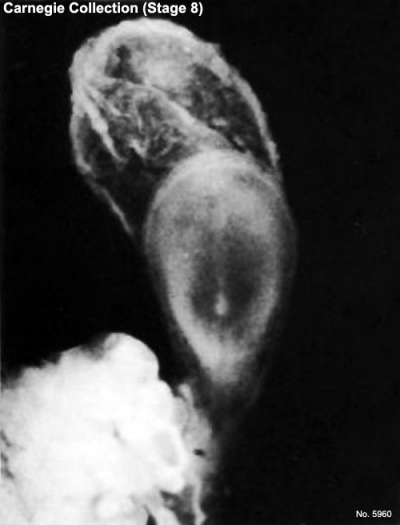
Dorsal view. Primitive node appears as a conspicuous opaque region with the notochordal process extending rostrally. |

Ventral view. Notochordal plate visible. |
| iBook - Carnegie Embryos | |
|---|---|
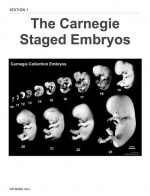
|
|
Serial Sections

|

|
Hill Collection
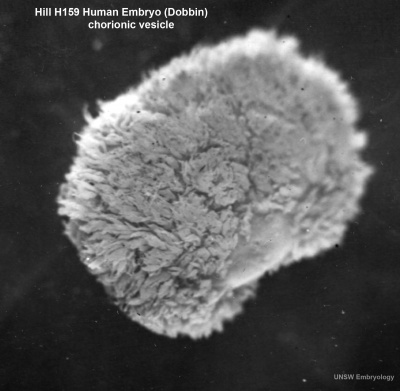
|
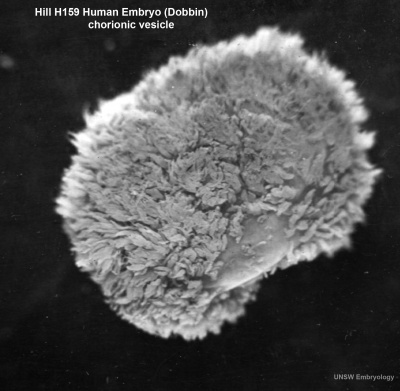
|
| chorionic vesicle stereo view 1 | chorionic vesicle stereo view 2 |
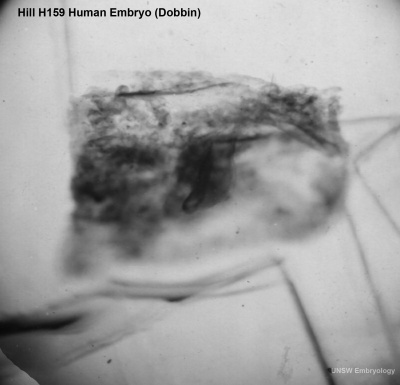
|
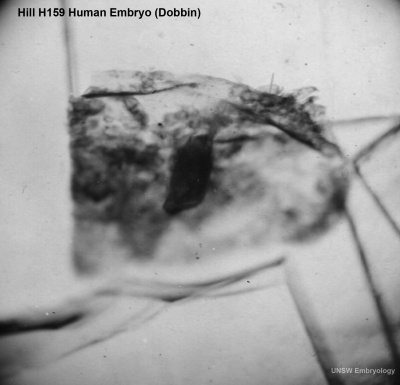
|
| embryo stereo view 1 | embryo stereo view 2 |
Image source: The images from the Hill Collection (part of the Embryological Collection) are reproduced with the permission of the Museum für Naturkunde, Leibniz Institute for Research on Evolution and Biodiversity. Images are for educational purposes only and must not be reproduced electronically or in writing without permission from the Museum für Naturkunde Berlin.
- Links: Hill Collection
This Embryology category shows pages and media related to Carnegie stage 8 of embryonic development that occurs during Week 3 (post-fertilisation) or gestational age, GA, LMP week 5.
| Stage 8 Links: Week 3 | Gastrulation | Lecture | Lecture | Somitogenesis | Lecture - Mesoderm | Lecture - Ectoderm | Lecture - Early Vascular | Science Practical | Carnegie Embryos | Category:Carnegie Stage 8 | Next Stage 9 |
| Historic Papers: 1920 Mateer Embryo | 1931 Head-Process | 1931 Prochordal Plate | 1931 neurenteric canal |
| Week: | 1 | 2 | 3 | 4 | 5 | 6 | 7 | 8 |
| Carnegie stage: | 1 2 3 4 | 5 6 | 7 8 9 | 10 11 12 13 | 14 15 | 16 17 | 18 19 | 20 21 22 23 |
| Carnegie Collection - Stage 8 | ||||||||||
|---|---|---|---|---|---|---|---|---|---|---|
| Serial No. | Grade | Fixative | Embedding Medium | Plane | Thinness (µm) | Stain | Year | Notes | ||
| 1399 | Poor | Formol | P | Transverse | 10 | (Stain - Haematoxylin Eosin) etc. | 1916 | "Mateer embryo" described by Streeter (1920a)[1] | ||
| 3412 | Poor | Formol | P | Transverse | 5-15 | Al. coch. E. au., or. | 1921 | |||
| 5960 | Good | Kaiserling | P | Transverse | 5 | Al. coch. & eosin | 1929 | Heuser (1932b)[2] | ||
| 6630 | Poor | Formol | P | Oblique | 6 | (Stain - Haematoxylin Eosin) | 1932 | |||
| 6815 | Poor | Formol | P | Oblique | 10 | Al. coch., or. G | 1933 | |||
| 7170a and b 7545 | Poor | Alc. | C-P | Transverse | 6 | (Stain - Haematoxylin Eosin) | 1935 | Twins | ||
| 7568 | Poor | Formoi | C-P | Transverse | 6 | (Stain - Haematoxylin Eosin) | 1938 | |||
| 7640 | Good | Formol & Bouin | P | Transverse | 10 | (Stain - Haematoxylin Eosin) | 1939 | George (1942)[3] | ||
| 7666 | Exc. | Formol-chrom. subl. | C-P | Transverse | 6 | (Stain - Haematoxylin Eosin) | 1939 | "H. 1515" | ||
| 7701 | Exc. | ? | C-P | Transverse | 8 | (Stain - Haematoxylin Eosin) | 1939 | |||
| 7822 | Good | Formoi | C-P | Transverse | 10 | (Stain - Haematoxylin Eosin) | 1940 | |||
| 7949 | Good | Zenker | p | Sagittal | 10 | (Stain - Haematoxylin Eosin) etc. | 1941 | |||
| 7972 | Good | Alc. & Bouin | C-P | Sagittal | 6 | (Stain - Haematoxylin Eosin) | 1942 | |||
| 8255 | Exc. | Bouin | C-P | Sagittal | 8 | (Stain - Haematoxylin Eosin), phlox. | 1944 | Slides showing embryo returned to Dr. Patten in 1962 | ||
| 8320 | Good | Formol | C-P | Sagittal | 8 | (Stain - Haematoxylin Eosin), phlox. | 1945 | |||
| 8352 | Good | Formol | C-P | Transverse | 8 | (Stain - Haematoxylin Eosin), phlox. | 1946 | |||
| 8371 | Poor | Alc. & Bouin | C-P | Sagittal | 8 | (Stain - Haematoxylin Eosin), phlox. | 1946 | |||
| 8671 | Exc. | Alc. & Bouin | C-P | Sagittal | 6 | (Stain - Haematoxylin Eosin), phlox. | 1949 | |||
| 8725 | Exc. | Alc. & Bouin | C-P | Sagittal | 6 | (Stain - Haematoxylin Eosin), phlox. | 1949 | Preparation method described by Heard (1957)[4] | ||
| 8727 | Exc. | Alc. & Bouin | C-P | Transverse | 8 | (Stain - Haematoxylin Eosin), phlox. | 1949 | Germ disc folded, possibly double (Hertig, 1968, fig. 180)[5] | ||
| 8820 | Good | Zenker-formol | ? | Transverse | 10 | (Stain - Haematoxylin Eosin) | 1951 | "Jones-Brewer I" (H. 1459) described by Jones and Brewer (1941)[6] | ||
| 9009a and b 9123 | Good | Formol | C-P | Sagittal | 6 | (Stain - Haematoxylin Eosin) | 1952 | Twins described briefly by Heuser (1954)[7] | ||
| 8371 | Good | Formol | C-P | Sagittal | 6 | (Stain - Haematoxylin Eosin) | 1953 | |||
| 9251 | Good | ? | C-P | Sagittal | 10-12 | Azan, H. & phlox. | 1954 | |||
| 9286 | Exc. | Formol | C-P | Transverse | 8 | Azan | 1955 | |||
| 10157 | Exc. | Formol | C-P | Transverse | ? | Cason | 1967 | |||
| 10174 | Exc. | Bouin | p | Transverse | 8 | Cason | 1967 | |||
Abbreviations
| ||||||||||
References
| ||||||||||
An historic example of this stage is shown by the Dobbin embryo, described in detail by the series of papers by Hill and Florian (1931a,b,c).[1][2][3] Abortion. Chorion, 11.5 x 8.5 x 4.5 mm. Chorionic cavity, 9 x 5.5 x 2.5 mm. Embryonic disc (narrow type), 0.96 x 0.41 mm. Primitive streak, 0.42 mm to notopore. Notochordal process, 0.42 mm. Notochordal canal communicates with cavity of umbilical vesicle by seven openings, the caudalmost of which is the ventral opening of a very short neurenteric canal. Prechordal plate, 0.03 mm; rostral end of notochordal process was at first mistaken for prechordal plate.
- ↑ Hill, J. P., and Florian, J. 1931a. The Development of Head-Process and Prochordal Plate in Man J Anat. 1931 Jan;65(Pt 2):242-6. PMID 17104317
- ↑ Hill, J. P., and Florian, J. 1931b. A Young Human Embryo (Embryo Dobbin) with Head-Process and Prochordal Plate. Phil. Tran. Roy. Soc. London B, 219, 443-486.
- ↑ Hill, J. P., and Florian, J. 1931c. Further note on the pro-chordal plate in man. J. Anat., 46, 46-47. PMID 17104356
Other Embryo Examples
Based on O'Rahilly, R. and Müller (1987)[1] and listed in order of length of notochordal process.
- Pha XVII. Chorionic cavity, 3.317 x 2.79 x 0.714mm. Embryonic disc, 0.412 mm. This embryo is said to resemble No. 7802 (stage 7). In addition to a notochordal process (Mazanec, 1959[2]., fig. 104) of 0.01 mm, however, it is thought to show probably the Anlage of the notochordal canal and an unusually large prechordal plate. Possible primordial germ cells were seen in the wall of the umbilical vesicle. Presumed age, 16-17 days. Median projection published (ibid., fig. 44).
- Carnegie No. 8820, Jones-Brewer I. Described by Jones and Brewer (1941)[3]. Hysterectomy. Chorionic cavity, 6 x 5 x 2.5 mm. Embryonic disc (broad type), 0.58 x 0.78 mm (in straight line); 0.6 x 0.79 mm (over curve). Primitive streak, 0.22 mm. Primitive node (0.06 mm) situated somewhat rostral to midpoint of embryonic disc. Three small, discontinuous cavities in node “represent the beginning of a neurenteric canal” which has no dorsal opening and does not communicate with the umbilical vesicle. Notochordal process, 0.0414 mm, but with no canalization. Hemocytoblasts and primitive erythroblasts identified in wall of umbilical vesicle (Bloom and Bartelmez, 1940). Presumed age, 18½ days. Dorsal and median projections published (Jones and Brewer, 1941, figs. 11 and 12; Mazanec, 1959[2], fig. 48).
- Carnegie No. 9286 Embryonic disc, 1.13 x 0.77 mm. Primitive streak, 0.38 mm. Notochordal process, 0.15 mm. An excellent specimen reconstructed by O'Rahilly and Müller (1981, fig. 3), who give details of ten other Carnegie specimens
- Carnegie No. 9009. Described briefly in an abstract by Heuser (1954). Hysterectomy. Monozygotic twin embryos. Embryonic discs, 0.9 and 0.66 mm. In each: primitive node in middle of disc, notochordal process with first evidence of canalization. Notochordal processes, 0.16 and 0.07 mm. Assigned to horizon VIII by Heuser, who estimated the age as 17 days. Reconstructed by O’Rahilly and Müller (1981, fig. 2B,C).
- Shaw. Described by Gladstone and Hamilton (1941)[4]. Hysterectomy. Chorion, 11 x 4.04 mm. Chorionic cavity, 8 x 3 mm. Embryonic disc (broad type), 1.05 x 1.34 mm. Notochordal process, 0.17 mm. Primitive pit and notochordal canal (which does not open into the umbilical vesicle). Prechordal plate identified but doubted by Mazanec (1959)[2]. No neural groove. Possible amniotic duct. Hemopoiesis (hemocytoblasts and primitive erythroblasts) under way in wall of umbilical vesicle and in connecting stalk. Chorionic villi and endometrium described by Hamilton and Gladstone (1942); trophoblast further described by Hamilton and Boyd (1960). Presumed age, 18 days. Median projection published (Gladstone and Hamilton, 1941; Mazanec, 1959[2], fig. 58).
- Wa 17 (Wagner). Described by Grosser (1931a,b).[5][6] Hysterectomy. Chorionic cavity, 8.5 x 8.5 x 7.5 mm. Embryonic disc (narrow type), 0.98 x 0.7 mm. Primitive streak, 0.5 mm. Notochordal process, 0.18 mm. Possible dorsal and ventral openings of the notochordal canal. Prechordal plate, 0.075 mm. Presumed age, about 19 days. Dorsal and median projections published (Grosser, 1931a, figs. 4 and 3; Hill and Florian, 1931b, fig. 7; Mazanec, 1959[2], fig. 59).
- Carnegie No. 8671. Low-power photomicrographs reproduced by Hertig (1968, figs. 47 and 181). Notochordal process, 0.23 mm.
- Kl. 13. Described by Grosser (1913). Traumatic abortion following salpingo-oophorectomy. Chorionic cavity, 8 x 6 mm. Embryonic disc, 0.67 x 0.5 mm. Primitive streak, 0.27 mm. Notochordal process, 0.2 mm. Notochordal canal, 0.25 mm (Florian, 1934c) with dorsal pit and ventral opening: notochordal plate intercalated in endoderm. Possible prechordal plate. Presumed age, about 18 days. Median projection published (Grosser, 1913, plate 27, fig. 4; Mazanec, 1959[2], fig. 62). Compared with other specimens by Grosser (1934).
- HEB-42. Described by Mazanec and Musilovà (1959). Curettage. Embryonic disc, 1.17 x 0.72 mm; 1.43 mm by flexible scale. Primitive streak, 0.54 mm. Primitive node, 0.06 mm. Primitive pit. Notochordal process, 0.25 mm. Small cavity (primordium of notochordal canal) in notochordal process. Prechordal plate not mentioned. Presumed age, 17-18 days. Dorsal and median projections published (ibid., figs. 1 and 2).
- Dy (Dyhrenfurth). Described by Triepel (1916)[7]. Abortion. Embryonic disc, 1.6 x 1.04 mm. Primitive streak, 0.11 mm. Notochordal process and plate, 0.3 mm. Primitive pit, neurenteric canal, and neural groove believed to be present. Anlagen of hypophysis and optic vesicles claimed unconvincingly (plane of section unsuitable). Embryonic disc bent ventrally through a right angle (normality of specimen questioned). First somite probably not present.
- 23 Somites Thompson and Brash (1923)[8] described a hysterectomy specimen that showed a chorionic cavity of 10 x 7.5 x 4 mm. Embryonic disc (broad type), 0.68 x 0.9 mm. Primitive streak and groove present. Notochordal process, 0.3 mm, with no distinct lumen but notochordal canal about to appear. Mazanec (1959) considered that, on the basis of the reconstruction, the notochordal process could not be more than 0.23 mm. Definite prechordal plate (Hill and Florian, 1931b). Rough dorsal and median drawings included (Thompson and Brash, 1923, figs, 2 and 3) and median projection published (Mazanec, 1959, fig. 55). This embryo belongs either to stage 7 or to stage 8.
- Schö (Schönholz). Described by Waldeyer (1929a,b)[9][10] Hysterectomy. Embryonic disc, 0.99 x 1.03 x 0.11 mm. Primitive streak, 0.51 mm, and node. Primitive groove and pit: “indentation” is perhaps “first Anlage of [notochordal] canal.” Notochordal process, 0.34 mm. Prechordal plate. Said to lie between Hugo (stage 7) and Peh. l-Hochstetter (stage 8). Dorsal and median projections published (ibid., figs. 6 and 5; Hill and Florian, 1931b, figs. 6 and 14; Mazanec, 1959[2], fig. 57).
- Dobbin. Important specimen described in detail by Hill and Florian (1931a,b,c).[11][12][13] Abortion. Chorion, 11.5 x 8.5 x 4.5 mm. Chorionic cavity, 9 x 5.5 x 2.5 mm. Embryonic disc (narrow type), 0.96 x 0.41 mm. Primitive streak, 0.42 mm to notopore. Notochordal process, 0.42 mm. Notochordal canal communicates with cavity of umbilical vesicle by seven openings, the caudalmost of which is the ventral opening of a very short neurenteric canal. Prechordal plate, 0.03 mm; rostral end of notochordal process was at first mistaken for prechordal plate. Dorsal and median projections published (Hill and Florian, 1931b, figs. 1 and 2; Mazanec, 1959[2], fig. 60). The scale in fig. 3 of Hill and Florian (1931b) is incorrect (Florian, 1934c). Specimen is now housed in Hubrecht Laboratory, Utrecht (No. H91; HH 159).
- Carnegie No. 5960 Important specimen described by Heuser (1932b). Hysterectomy. Chorion, 15 x 14 x 9 mm. Embryonic disc (narrow type), 1.25 x 0.68 mm (in straight line); 1.53 x 0.75 mm (by flexible scale). Primitive streak, 0.5 (0.44?) mm. Primitive node, 0.2 (0.06?) mm, slightly caudal to midpoint of embryonic disc. Notochordal process, 0.42 mm (George, 1942). Notochordal canal (about 0.4 mm) opens ventrally. Prechordal plate, 0.15 mm. Florian (1934b), however, believed that the prechordal plate was situated further rostrally than shown by Heuser. Angiogenesis in umbilical vesicle, body stalk, and chorion. Angiogenesis in chorion described by Hertig (1935). Neural groove. Presumed age, 18 days. Dorsal and median projections published (Heuser, 1932b, figs. 33 and 47; Mazanec, 1959[2], fig. 63).
- Carnegie No. 7545. Embryonic disc, 1.52 x 1.03 mm. Primitive streak, 0.61 mm. Notochordal process, 0.43 mm. Reconstructed by O'Rahilly and Müller (1981, fig. 2E).
- Carnegie No. 7640. Described by George (1942). Tubal. Embryonic disc (broad type), 1.01 x 0.83 mm (in straight line); 1.16 mm by flexible scale. Primitive streak, node, and pit present. Notochordal process, 0.44 mm. Notochordal canal continuous with primitive pit; floor of canal has disappeared in its middle quarter. Prechordal plate, 0.12 mm, said to contain continuation of notochordal canal. Neural groove. Dorsal and median projections published (ibid., figs. 1 and 2).
- Peh. 1-Hochstetter (Peham). Described by Rossenbeck (1923). Chorion, 10 x 7.7 mm. Chorionic cavity, 6.8 x 5.3 mm. Embryonic disc (broad type; this might be disputed, however), 1.77 (Florian, 1934) x 1 mm. Primitive streak, 0.69 mm. Notochordal process (Mazanec, 1959[2], figs. 107 and 108), 0.6 mm. Notochordal canal ready to break through into umbilical vesicle in one section. Prechordal plate (confirmed by Florian, 1931), 0.08 mm. Indication of hindgut (Florian, 1934b). Allanto-enteric diverticulum (Florian, 1930a). Dorsal and median projections published (Hill and Florian, 1931b, figs. 9 and 16; Mazanec, 1959, fig. 61).
- R. S. (Robb Smith). Described by Odgers (1941)[14]. Hysterectomy. Embryonic disc (broad type), 1.5 x 1.36 mm. Primitive streak, 0.4 mm. Notochordal plate (intercalated in endoderm), 0.7 mm. Neurenteric canal extends vertically from amniotic cavity to umbilical vesicle. Prechordal plate, 0.29 mm, containing perhaps remains of notochordal canal. Commencing neural groove. Dorsal and median projections published (ibid., figs. 1 and 2).
- Western Reserve No. 1. Described by Ingalls (1918)[15]. Abortion. Chorion, 9.1 x 8.2 x 6.5 mm. Chorionic cavity, 8 x 7 x 5 mm. Embryonic disc (narrow type), 2 (1.87?) x 0.75 mm. Primitive streak, 0.67 mm. Primitive pit present. Notochordal process, 0.75 (0.65?), Hill and Florian, 1931b) mm. Notochordal canal, 0.34 mm, with three ventral openings into umbilical vesicle. Prechordal plate identified (but not 0.4 mm in length, according to Mazanec, 1959). Dorsal and median projections published (Hill and Florian, 1931b[12], figs. 10 and 17; Mazanec, 1959[2], fig. 64).
Precise measurements of the notochordal process have not been provided in the accounts of the following embryos.
- M’lntyre. Described by Bryce (1924)[16] and M’Intyre (1926). Hysterectomy. Chorion, 14 x 13 x 8 mm. Embryonic disc, 1.37 x 0.5 mm. Primitive streak, 0.32 mm. Notochordal plate, neurenteric canal, and prechordal plate (with cavity) present. Neural groove, future foregut, U-shaped pericardial cavity, and “some general resemblance to somites” noted. Rough dorsal and median drawings included (Bryce, 1924[16], figs. 5 and 49). May belong to stage 9.
- Frassi’s specimen (Keibel, 1907; Frassi, 1908) was illustrated as Normentafel No. 1 by Keibel and Elze (1908). Embryonic disc, 1.17 x 0.6 mm. Primitive streak and neurenteric canal identified. Neural groove. No somites.
- Gle., or Gläveke (von Spee, 1889 and 1896). Illustrated as Normentafel No. 2 by Keibel and Elze (1908). See also Kollmann (1907) and Keibel and Mall (1910, 1912). Chorion, 6 x 4.5 mm. Chorionic cavity, 5.3 x 3.8 mm. Embryonic disc, 1.54 mm. Primitive streak and node, notochordal plate, and neurenteric canal (Van Beneden, 1899) identified (Keibel and Mall, 1912, fig. 231). Neural groove. Indication of foregut and pericardial cavities. Anlage of endocardium. No somites detected, although a small cavity on the left side (Keibel and Elze, 1908, fig. 4f) could be considered as the first Anlage of a myocoele. May belong to stage 9.
- Strahl (1916)[17] described briefly a specimen that possessed a notochordal process and canal, and apparently a prechordal plate. A median drawing was included (ibid., fig. a) but measurements were not provided.
- Vuill., or Vulliet. Illustrated schematically by Eternod (1899a and 1909), Kollmann (1907), and Keibel and Mall (1912). Chorion, 10 x 8.2 x 6 mm. Chorionic cavity, 9 x 7.2 x 5 mm. Embryonic disc, 1.3 mm. Notochordal and neurenteric canals (Eternod, 1899b).
- Cordier and Coujard (1939) described an embryo of 1.05 mm showing a neural groove and folds, notochordal canal, primordial germ cells, but no somites, no intra-embryonic coelom, and no cardiac rudiment.
- Carnegie No. 8727. Photomicrograph reproduced by Hertig (1968, fig. 180). The partial duplication of the embryonic disc shown in this specimen would presumably have resulted in conjoined twins.
Certain other embryos that probably belong to stage 8.
- Krukenberg (1922) and Fitzgerald- Brewer I (Brewer and Fitzgerald, 1937).
- Boerner-Patzelt and Schwarzacher (1923) described an unsatisfactory specimen (embryonic disc, 0.47 x 0.43 mm) that showed a neurenteric canal,
- Broman (1936) described in detail an abnormal specimen (“Lqt”) in which the primitive streak showed “overgrowth” in relation to the neurenteric canal, resulting in a dislocation within the embryonic disc.
Events
References
- ↑ O'Rahilly R. and Muller F. Stages in early human development. In Feichtinger, W., and Kemeter, P. (ed.). Future Aspects in Human in vitro Fertilization. (1987) Springer, Berlin.
- ↑ 2.00 2.01 2.02 2.03 2.04 2.05 2.06 2.07 2.08 2.09 2.10 Mazanec, K. 1959. Blastogenese des Metjschen. Fischer, Jena.
- ↑ Jones, H. O., and Brewer, J. I. 1941. A human embryo in the primitive-streak stage (Jones-Brewer ovum I). Carnegie Instn. Wash. Publ. 525, Contrib. Embryol., 29, 157-165.
- ↑ W J Hamilton, R J Gladstone A presomite human embryo (Shaw) - the implantation. J. Anat.: 1942, 76(Pt 2);187-203 PMID 17104888
- ↑ Grosser, O. 1931a. Primitivstreifen und Kopffortsatz beim Menschen. Verb. Anat. Ges., Erg. Heft Anat. Anz., 71,135—139.
- ↑ Grosser, O. 1931c. Weiteres uber den Primitivstreifen des Menschen. Verb. Anat. Ges., Erg. Heft Anat. Anz., 72, 42-44.
- ↑ Triepel, H. 1916. Ein menschlicher Embryo mit Canalis neurentericus. Chordulation. Anat. Hefte, 54, 149-185.
- ↑ Thompson, P., Description of a Human Embryo of Twenty-three Paired Somites. J Anat Physiol: 1907, 41(Pt 3);159-71 PMID 17232726
- ↑ Waldeyer, A. 1929a. Ein junges menschliches Ei in situ (Schönholz), Z Anal Entw., 90, 412-457
- ↑ Waldeyer, A. 1929b. Mesodermbildung bei einem jungen menschlichen Embryo. Anat Anz., 35, 145-151.
- ↑ Hill, J. P., and Florian, J. 1931a. The Development of Head-Process and Prochordal Plate in Man J Anat. 1931 Jan;65(Pt 2):242-6. PMID 17104317
- ↑ 12.0 12.1 Hill, J. P., and Florian, J. 1931b. A Young Human Embryo (Embryo Dobbin) with Head-Process and Prochordal Plate. Phil. Tran. Roy. Soc. London B, 219, 443-486.
- ↑ Hill, J. P., and Florian, J. 1931c. Further note on the pro-chordal plate in man. J. Anat., 46, 46-47. PMID 17104356
- ↑ Odgers, P. N. B. 1941. A presomite human embryo with a neurenteric canal (embryo R. S.). J. Anat, 75, 381-388.
- ↑ Ingalls NW. A human embryo before the appearance of the myotomes. (1918) Contrib. Embryol., Carnegie Inst. Wash. No.23 Publ. 227, 7:111-134.
- ↑ 16.0 16.1 Bryce, T. H. 1924. Observations on the early development of the human embryo. Trans. Roy. Soc. Edinburgh, 53, 533— 567.
- ↑ Strahl, H. 1916. Uber einen jungen menschiichen Embryo nebst Bemerkungen zu C. Rabl's Gastrulationstheorie. Anat. Hefte, 54, 113-147.
Additional Images
Historic Images
- Carnegie Stages: 1 | 2 | 3 | 4 | 5 | 6 | 7 | 8 | 9 | 10 | 11 | 12 | 13 | 14 | 15 | 16 | 17 | 18 | 19 | 20 | 21 | 22 | 23 | About Stages | Timeline
Cite this page: Hill, M.A. (2024, April 27) Embryology Carnegie stage 8. Retrieved from https://embryology.med.unsw.edu.au/embryology/index.php/Carnegie_stage_8
- © Dr Mark Hill 2024, UNSW Embryology ISBN: 978 0 7334 2609 4 - UNSW CRICOS Provider Code No. 00098G
